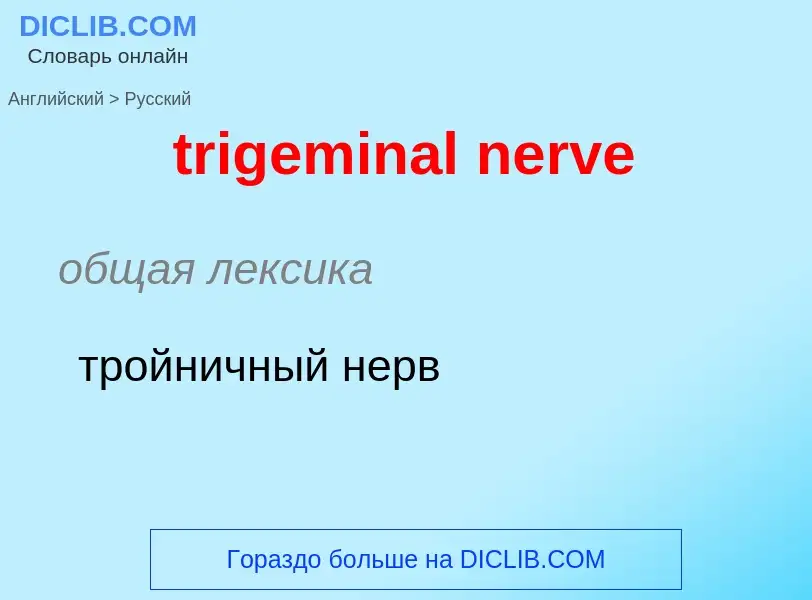Перевод и анализ слов искусственным интеллектом ChatGPT
На этой странице Вы можете получить подробный анализ слова или словосочетания, произведенный с помощью лучшей на сегодняшний день технологии искусственного интеллекта:
- как употребляется слово
- частота употребления
- используется оно чаще в устной или письменной речи
- варианты перевода слова
- примеры употребления (несколько фраз с переводом)
- этимология
trifacial nerve - перевод на русский
общая лексика
тройничный нерв
[trai'dʒeminəs]
анатомия
тройничный нерв
существительное
анатомия
тройничный нерв
[trai'dʒemin(ə)l]
общая лексика
тройничный
состоящий из трёх структур
относящийся к трём структурам
медицина
тригеминальный
синоним
Определение
Википедия

In neuroanatomy, the trigeminal nerve (lit. triplet nerve), also known as the fifth cranial nerve, cranial nerve V, or simply CN V, is a cranial nerve responsible for sensation in the face and motor functions such as biting and chewing; it is the most complex of the cranial nerves. Its name (trigeminal, from Latin tri- 'three', and -geminus 'twin') derives from each of the two nerves (one on each side of the pons) having three major branches: the ophthalmic nerve (V1), the maxillary nerve (V2), and the mandibular nerve (V3). The ophthalmic and maxillary nerves are purely sensory, whereas the mandibular nerve supplies motor as well as sensory (or "cutaneous") functions. Adding to the complexity of this nerve is that autonomic nerve fibers as well as special sensory fibers (taste) are contained within it.
The motor division of the trigeminal nerve derives from the basal plate of the embryonic pons, and the sensory division originates in the cranial neural crest. Sensory information from the face and body is processed by parallel pathways in the central nervous system.


![Dermatome]] distribution of the trigeminal nerve Dermatome]] distribution of the trigeminal nerve](https://commons.wikimedia.org/wiki/Special:FilePath/Gray784.png?width=200)


![C = Cervical segment, S = Sacral segment, VPL = [[Ventral posterolateral nucleus]], SI = [[Primary somatosensory cortex]], VM = [[Ventromedial prefrontal cortex]], MD = [[Medial dorsal thalamic nucleus]], IL = [[Intralaminar nucleus]], VPM = [[Ventral posteromedial nucleus]], Main V = [[Main trigeminal nucleus]], Spinal V = [[Spinal trigeminal nucleus]] C = Cervical segment, S = Sacral segment, VPL = [[Ventral posterolateral nucleus]], SI = [[Primary somatosensory cortex]], VM = [[Ventromedial prefrontal cortex]], MD = [[Medial dorsal thalamic nucleus]], IL = [[Intralaminar nucleus]], VPM = [[Ventral posteromedial nucleus]], Main V = [[Main trigeminal nucleus]], Spinal V = [[Spinal trigeminal nucleus]]](https://commons.wikimedia.org/wiki/Special:FilePath/Touch Pain Pathways.png?width=200)
